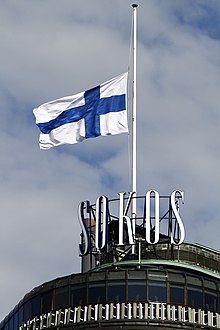
Back تنكيس علم Arabic Trauerbeflaggung German Μεσίστια σημαία Greek Flago ĉe duonmasto Esperanto Media asta Spanish Leinalipp Estonian Makila erdira Basque نیمافراشتگی Persian Suruliputus Finnish Drapeau en berne French
This article has multiple issues. Please help improve it or discuss these issues on the talk page. (Learn how and when to remove these messages)
|


Half-mast or half-staff (American English) refers to a flag flying below the summit of a ship mast, a pole on land, or a pole on a building. In many countries this is seen as a symbol of respect, mourning, distress, or, in some cases, a salute.[1]
The tradition of flying the flag at half-mast began in the 17th century.[2] According to some sources, the flag is lowered to make room for an "invisible flag of death" flying above.[3] However, there is disagreement about where on a flagpole a flag should be when it is at half-mast. It is often recommended that a flag at half-mast be lowered only as much as the hoist, or width, of the flag.[4][5] British flag protocol is that a flag should be flown no less than two-thirds of the way up the flagpole, with at least the height of the flag between the top of the flag and the top of the pole.[6] It is common for the phrase to be taken literally and for a flag to be flown only halfway up a flagpole,[7] although some authorities deprecate that practice.[5]
When hoisting a flag that is to be displayed at half-mast, it should be raised to the finial of the pole for an instant, then lowered to half-mast. Likewise, when the flag is lowered at the end of the day, it should be hoisted to the finial for an instant, and then lowered.[7]
- ^ "Flags at half mast". www.crwflags.com.
- ^ Trex, Ethan (20 December 2012). "Why are flags flown at half-staff in times of mourning?". The Week. Archived from the original on 24 December 2012. Retrieved 22 June 2015.
- ^ Bartram, G., A Guide to Flag Protocol in the United Kingdom Archived 11 August 2013 at the Wayback Machine, an extract from the book British Flags and Emblems, The Flag Institute.
- ^ "What is the proper etiquette for lowering the flag to half staff?". The Flag Shop. Retrieved 29 May 2017.
- ^ a b "Basic Flag Protocol and Etiquette". Newton Newton Flag & Banner Makers Limited. Archived from the original on 29 August 2003. Retrieved 29 May 2017.
- ^ "Flags at half-staff". The Flag Institute.
- ^ a b "What is the proper procedure to fly your flag at half-staff?". American Flag & Pole Co. Archived from the original on 1 December 2017. Retrieved 29 May 2017.